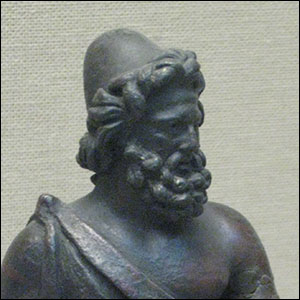
Hephaistos was the lame son of Hera. In the Iliad by Homer, Hephaistos reveals how he was ejected from Mount Olympos before he was granted the prestige accorded a god. At the climax of a domestic dispute, Hephaistos stood with his mother in defiance of Zeus. In his rage, the Olympian Zeus caught Hephaistos by the foot and hurled him from the magic threshold of Mount Olympos to the earth far below. Three days later Hephaistos landed on the island of Lemnos, broken and nearly lifeless. The Nereid Thetis and Okeanid Eurynome found the shattered god and nursed him back to health. Thetis later became the mother of Achilles and Eurynome the mother of the Charites (Graces).
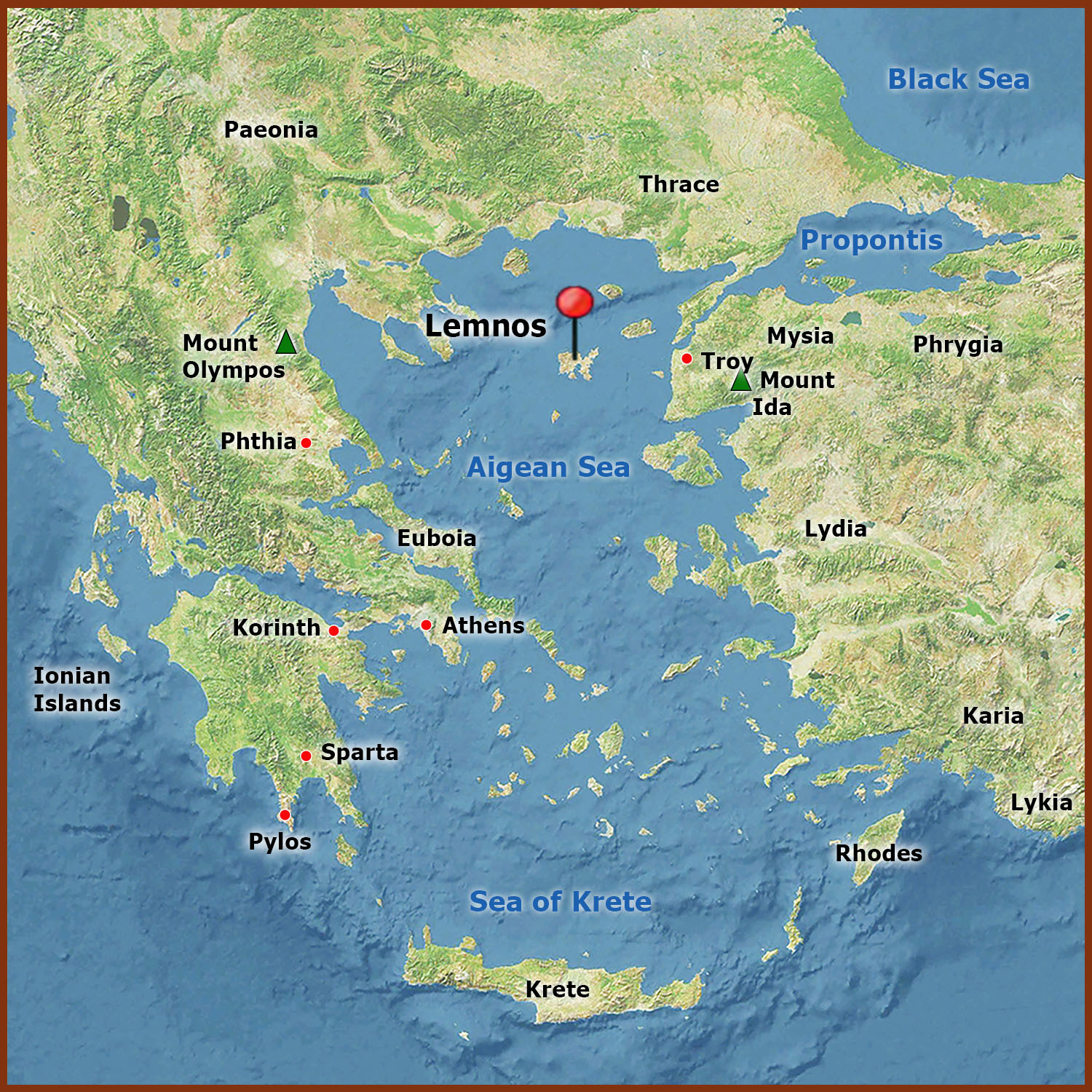
Thetis and Eurynome were responsible for saving Hephaistos's life and he never forgot their kindness. Hera was violently shamed at the sight of her lame son and would have done him further harm had not Thetis and Eurynome hidden him in a cave. He worked secretly with the two goddesses for nine years perfecting his craft before emerging to claim his rightful place among the Olympians.
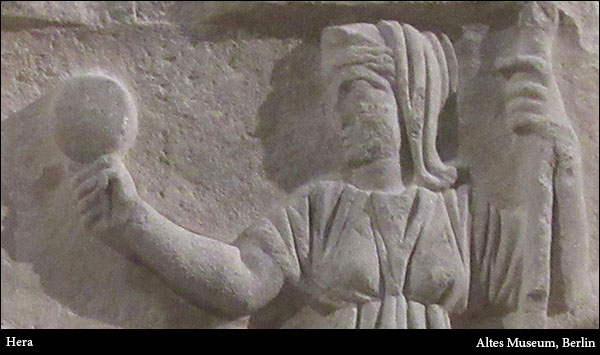
Hera told a different story as to how Hephaistos was ejected from Mount Olympos ... in the Homeric Hymn to Apollon, she says that she, not Zeus, cast Hephaistos into the sea. Hera also curses Thetis for caring for Hephaistos and says that surely there must have been other services Thetis could have performed for the Immortals without encouraging her lame son.
Hephaistos's skill with all things mechanical was phenomenal. He fashioned his own mechanical helpers to assist him in his work ... they were golden and in the form of living young women ... strong, vocal and intelligent. He built tripods that move of their own accord at the feasts on Mount Olympos. He also built the homes of all the Olympians and fitted them with clever locks that the other Immortals cannot undo. With the help of the Cyclopes, he hammered out lightning bolts for Zeus and all manner of subtle and gentle devices for the Immortals and heroes as well as for mere mortals. Some of his finest robotic creations were not in his workshop or displayed on Mount Olympos.
Examples of Hephaistos's brilliant creations could be seen on the island of Scheria, which is inhabited by a race called the Phaiakians. The Phaiakians were descended from Poseidon (lord of the sea) but they were favored by other Immortals as well. Usually, when the Immortals visited Scheria they would mingle with the Phaiakians without disguises but when Athene took Odysseus to the capital city of Scheria, she took the form of young maiden ... her disguise was to keep her identity secret from Odysseus ... at her contrivance, she and Odysseus were both invisible to the Phaiakians.

Hephaistos built several unique devices for King Alkinoos of the Phaiakians. He fashioned gold and silver dogs to stand guard on either side of the golden palace doors ... the dogs were immortal and ever vigilant. The walls inside the palace were lined with golden youths holding torches to provide light ... the dogs and the golden youths are fully robotic.
Two of Hephaistos's most stunning creations were the shields he made for Herakles and Achilles. Both shields were alive with animated scenes from everyday life as well as brutally realistic acts of warfare and mayhem.
Herakles, a son of Zeus, carried the shield crafted by Hephaistos when he confronted and killed the son of Ares, Kyknos. The poem The Shield of Herakles by Hesiod vividly described the divinely crafted shield. Odysseus, the fearless Trojan War veteran, encountered the 'shade' of Herakles when he went to the entrance to the Underworld to consult with the souls of the dead. He noted the grisly armor Herakles wore and sincerely hoped the artist who designed those horrid images would never again display his craft ... he was obviously unaware of who made the shield or he would have never uttered such blasphemy.
Hephaistos gave Achilles a shield as part of a suit of armor he wore during the final battle at Troy. Achilles was the most fearless and feared warrior at Troy ... his shield added to his terrifying presence.
The Homeric Hymn to Hephaistos praises him for giving humankind the skills and crafts that allowed them to emerge from the caves and live in houses and have peaceful lives.
Hephaistos never forgot the kindness Thetis and Eurynome showed him after he had been ejected from Mount Olympos. When Thetis got married, Hephaistos honored her husband Peleus by fashioning the head of an ashen spear that had been cut by the Centaur Cheiron and polished by the goddess Athene ... it was only natural that when Thetis needed some divine armor for her son Achilles she would go to Hephaistos for help.
Hephaistos's wife Charis greeted Thetis when she arrived at Hephaistos's home-workshop. Hephaistos did not hide his pleasure at seeing Thetis ... he reminisced about her kindness to him and how he was forever in her debt.
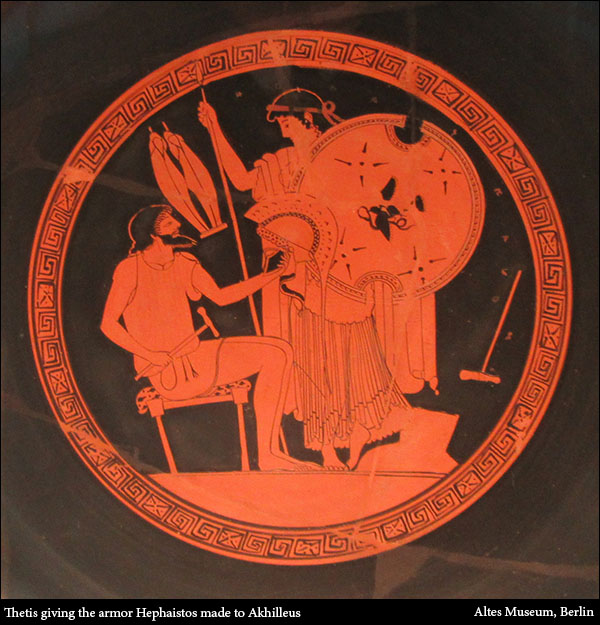
Thetis told Hephaistos about the plight of her son Achilles and the impending doom of the Greeks at Troy ... she told him how Trojan Prince Hektor had taken Achilles's armor leaving her son without protection for the upcoming battles. Hephaistos did not hesitate to agree to make Achilles new armor ... he gathered his robot assistants and went to work.
The armor Hephaistos made for Achilles was so bright and obviously god-made, it flashed as if it contained the light of the sun ... Achilles's comrades could not look directly at the armor and the Trojans fled at the sight of such a divinely clad warrior. The Trojans who did not retreat were killed without mercy and stripped of their armor and their honor by the seemingly invincible Achilles. But even the skill of Hephaistos could not protect Achilles from the web and weave of Erinys (Fate). Achilles was killed on the battlefield of Troy and the armor Hephaistos gave him became the focus of a fierce dispute that resulted in perpetual hatred.
The death of Achilles was necessary for the completion of the Trojan War. We are not told the exact circumstances of Achilles's death other than that he was killed by an arrow shot by Prince Alexandros (Paris) with the assistance of the god, Apollon. The assumption is that Achilles was shot in the heel, which was the only unprotected part of his body. Another assumption is that his heel was also the weakest part of his semi-divine body because his mother Thetis held him by his heel when she christened him in water to make him invincible. Regardless, Achilles's death was in no way the fault of Hephaistos or any flaw in the armor he made for Achilles ... Achilles was slated to die at Troy no matter who or what protected him.
When a soldier was killed in battle, it was customary for the victor to strip the armor from the corpse ... the armor was a trophy as well as a valuable commodity. Achilles's armor was priceless ... whoever took the armor from Achilles's dead body would have one of the greatest prizes of the Trojan War. With Achilles lying dead in the dust, the Trojans and Greeks converged for one of the most intense fights of the ten-year war. Finally, two of the strongest Greek warriors joined forces to rescue Achilles's body ... Telamonian Aias and Odysseus charged at the Trojans ... Odysseus battered the Trojans while Aias grabbed Achilles's body and carried it back behind the Greek battle-lines.
A dispute arose immediately as to which of the two should be awarded Achilles's god-crafted armor—Telamonian Aias or Odysseus. Nestor, the oldest and perhaps wisest member of the Greek army, suggested that a spy be sent to the walls of Troy to listen to what the Trojans were saying and see who they thought should get the armor, Odysseus or Aias. The spy reported that the Trojans were saying that even though Aias was very brave, a woman could have carried Achilles's body out of the fighting. On the other hand, Odysseus was the one who was in the thick of the fighting ... he deserved the armor.
Lots were drawn and Odysseus was given the armor Hephaistos made for Achilles ... as fate would have it, the armor was lost at sea with Odysseus's Trojan plunder and all of his companions. When Odysseus was at the entrance to the Underworld, he saw the sulking 'shade' of Aias and wanted to speak to the fallen hero but Aias would not even acknowledge Odysseus's presence. Aias had never forgiven Odysseus, not even in death, for the perceived injustice of not being awarded the dazzling armor Hephaistos crafted for Achilles.
Hephaistos allied himself with his mother and Athene to support the Achaians and fight against the Trojans. Even so, Hephaistos had two sons on the Trojan army and at one point, assisted the god Apollon when he routed the Achaians. The Immortals had complicated loyalties throughout the Trojan War.
References to devices and pieces of armor devised by Hephaistos are sprinkled throughout the Iliad by Homer. Trojan Prince Hektor coveted the corset of Diomedes ... every soldier marveled at Achilles's armor ... Hera promised Hypnos, god of sleep, a throne if he would help her befuddle Zeus ... Agamemnon, the Achaian commander-in-chief, carried a scepter symbolizing his authority ... all those items were designed and crafted by Hephaistos.
A trojan priest named Dares had two sons serving in the Trojan army—Idaios and Phegeus. Mounted in their chariot, the two young men charged at the Achaian commander Diomedes, who was advancing on foot. Phegeus jumped from the chariot and hurled his spear at Diomedes ... it flew harmlessly over Diomedes's shoulder. Before Phegeus could retreat, Diomedes's spear lodged in the center of his chest ... death was instantaneous. Seeing his brother dead in the dirt, Idaios lost his nerve and ran from the fight. He would have been stabbed in the back if Hephaistos had not shrouded him in darkness, saving his life so his father Dares, Hephaistos's loyal priest, would not be left without a son.
Hephaistos's active part in the fighting came when Achilles attacked the Trojans on the banks of the Xanthos River. Achilles threw the bodies of men and horses into the river until the waters ceased to flow. The river-god Xanthos rose from the depths and hurled wave after wave at Achilles ... trying to drown him. Hera urged Hephaistos to help Achilles by burning Xanthos. Hephaistos set the entire battlefield around the river ablaze. Xanthos retreated and begged for mercy. With Hera's approval, Hephaistos quenched the fires, allowing Achilles to resume his slaughter of the Trojans.
Hephaistos had at least three wives—Algaia (Splendor), Charis (Grace), and Aphrodite (Love).
The poem Theogony by Hesiod states that Hephaistos took Aglaia, the youngest of the Charites (Graces), as his wife. You might recall that when Hephaistos was hurled from Mount Olympos, Eurynome, mother of the Charites, was crucial to his survival ... perhaps allowing Hephaistos to marry Aglaia was Eurynome's way of rewarding the lame god for his resiliency despite his hard life. Since Aglaia was mentioned in Theogony, we might assume she was Hephaistos's first wife. No time frame was given for this marriage, but it probably preceded his other marriages by as much as several thousand years.
In the Iliad by Homer, we are told that Hephaistos's wife is Charis, which might be literally translated as Grace. Thetis's visit to Hephaistos took place in the tenth year or the Trojan War which would be approximately 1240 BCE ... Charis was with Hephaistos at that time. Charis was hospitable and welcoming to the goddess Thetis when she came to Hephaistos's home-workshop to consult with him about new armor for her son, Achilles.
Ten years later in the Odyssey by Homer, we learn that Hephaistos's wife is Aphrodite (goddess of love). This seems like an unlikely match, but the goddess of love can charm and seduce anyone she chooses ... Hephaistos obviously could not resist her ultimate feminine charisma. It appears that Aphrodite did not consider her relationship with Hephaistos exclusive because she had a secret love affair with Ares, god of war.
Helios (Sun) sees everything. He observed Aphrodite and Ares in the embrace of love and told Hephaistos. The noble smith began plotting his revenge in the best way he knew ... he devised a clever mechanism as a trap for the lovers. He enclosed his marriage bed with subtle and invisible wires and just as he planned, Aphrodite and Ares became ensnared and could not break free. In their helpless position, Hephaistos displayed them to the other Immortals while he proclaimed his anger and shame. He refused to release the humiliated couple until he received an adulterer's payment from Ares. In order to end the embarrassing scene, Poseidon offered to pay the adulterer's fee if Ares defaulted ... Hephaistos accepted those terms and loosed the humiliated lovers from their bonds.
Zeus gave Hephaistos the task of forming the first human woman as punishment to the men of the earth. The creation of the first woman was necessitated when he Rebel-God Prometheus stole fire from Zeus and gave it to the men suffering in their caves and hovels. As a fitting punishment for Prometheus, Zeus instructed Hephaistos to chain the Rebel-God to the Caucasus Mountains. To punish the men Prometheus tried to help, Zeus decided to trick Prometheus's brother into unleashing evil upon the world.
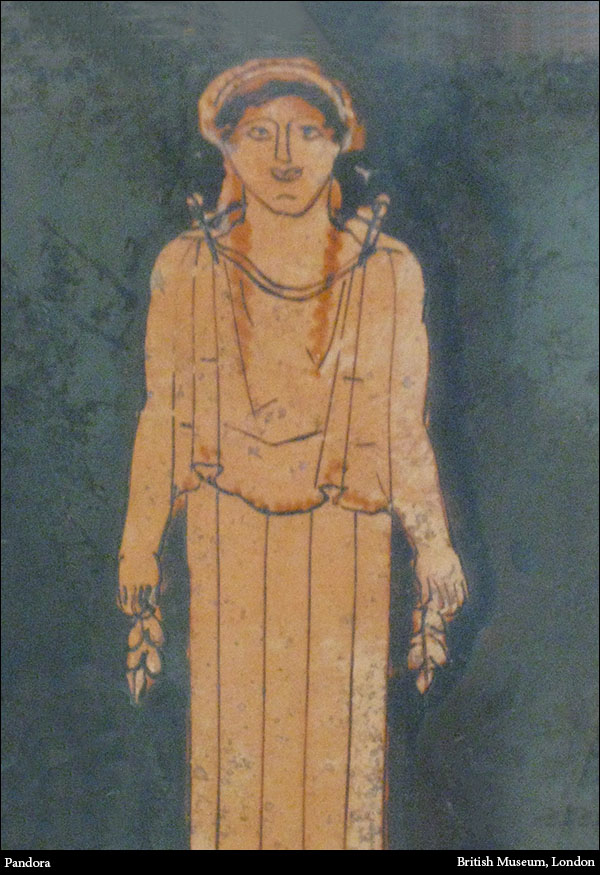
At Zeus's command, Hephaistos molded clay into the form of a modest young maiden ... he also fashioned an animated and vocal golden crown for her head. Athene taught the girl the skills of weaving and gave her dexterity. Aphrodite put a mist upon the maiden's head to engender longings and desire. Hermes gave her the mind of a hussy and a treacherous nature. The Charites and Peitho (Persuasion) gave her necklaces of gold and the Horae (Seasons) put a halo of flowers around her head.
She was named Pandora ... her name means All-Endowed because she was given gifts from various Immortals and was thus Endowed By All.
Zeus took Pandora to Prometheus's younger brother, Epimetheus ... he found her literally irresistible ... she was a dream come true. Prometheus warned his brother not to accept gifts from Zeus, but his warning went unheeded ... Epimetheus accepted Pandora and by doing so unleashed corruption and evil on the world.
Pandora's unveiling was not all bad ... the one thing she retained in her inner being was hope ... Ελπς ... true hope ... undiluted hope.
Residing on Mount Olympos, Hephaistos's relationship with Hera was tumultuous. At one point his anger prompted him to devise a golden chair fitted with invisible fetters that he presented to Hera as a gift. As soon as she was seated in the chair, Hera was unable to free herself. It's not clear whether it was Hera or one of the other Immortals who persuaded the god Dionysos to go to Hephaistos and encourage him to release his mother. Dionysos did what he does best, he made Hephaistos drunk and then unceremoniously returned the drunken god to Mount Olympos on the back of a donkey. Hephaistos freed Hera from the golden chair but the antagonistic mother-son relationship continued until the beginning of the Trojan War.
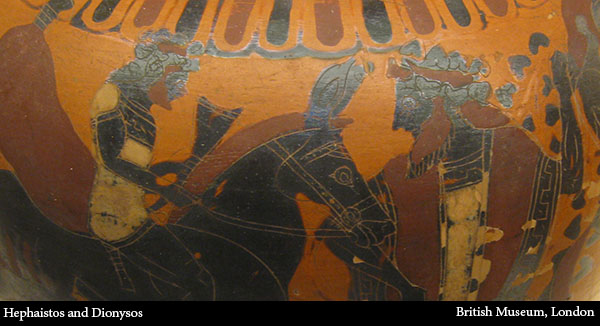
At the dawn of time, there lived a demigod named Orion who made an indelible mark on the earth and sky. He lived such a long time ago that many details of his life have been obscured but we are certain of several events because they were dutifully recorded.
We are told in the Astronomy that Orion was the son of Poseidon (lord of the sea) and Euryale ... Poseidon gave him the power to walk on water as if it were land. Orion became a renowned hunter of wild beasts as he traveled throughout Greece but when arrived on the island of Chios, he degraded his noble birthright by becoming drunk and assaulting a young maiden named Merope, daughter of Oenopion. Outraged by Orion's disgraceful treatment of his daughter ... Oenopion blinded Orion.
Orion fled to the island of Lemnos where he happened to encounter Hephaistos ... the lame god could sympathize with Orion and he gave him a servant named Kedalion to act as his guide. Orion carried Kedalion on his shoulders to point out the roads and help him find his way around the world.
While traveling in "the east," Orion came to the notice of Helios ... the sun god took pity on Orion and restored his sight. Orion seemed to have learned nothing from his ordeal ... he immediately resumed his prideful and indulgent life. When he ventured to the island of Krete he hunted with the goddesses Artemis and Leto ... his zeal for hunting made him boast that he would kill every wild animal on the earth. Offended by his boasting, Ge (Earth) sent a giant scorpion to kill Orion. Artemis and Leto persuaded Zeus to honor Orion by placing him in the heavens as a constellation.
Hephaistos was more of a builder than a fighter but he did not shirk his responsibilities when the Giants challenged the authority of Zeus and the other Olympians. In the course of the fighting, Hephaistos became faint from exhaustion and collapsed ... Helios put Hephaistos in his chariot and carried the debilitated god to safety. As a gesture of appreciation, Hephaistos gave gifts to Helios's son, King Aietes of Kolchis.
King Aietes was a fierce and proud man who had the distinction of having in his possession the Golden Fleece, which was from a flying ram created by the god Hermes. The ram was fashioned to help two children named Phrixus and Helle escape their evil stepmother, Ino. Helle fell from the flying ram's back and was drowned in the sea but Phrixus successfully flew to Kolchis where King Aietes welcomed him and allowed him to marry his daughter, Chalkiope. The ram was sacrificed and the Golden Fleece was kept in the Garden of Ares where it was guarded by an ever vigilant dragon. Possession of the Golden Fleece gave King Aietes much renown but it could not protect him from the inevitable fate of losing the Golden Fleece, two of his children and his reputation.
Hephaistos built an elaborate palace for King Aietes, which had features only the artificer of the Immortals could have conceived and built. The entrance to the palace had wide gates and columns topped by bronze triglyphs. Inside was a garden with vines covered with green foliage in full bloom. In the midst of the garden were four fountains. From one fountain poured milk, another supplied wine, the third gushed fragrant oil and the last fountain provided water that was cold in the summer and warm in the winter.
The inner courtyard had many well-fitted doors and chambers. Along each side of the courtyard were richly-wrought galleries with four lofty buildings. King Aietes lived in the tallest structure with Queen Eidyia. Aietes's son Apsyrtos occupied another tower, Aietes's daughters Medeia and Chalkiope occupied another and the remaining building was home to the palace handmaidens.
Hephaistos fashioned two bulls for King Aietes. The bulls had feet and mouths of bronze ... when the bulls breathed, flames came from their mouths. Hephaistos also made an unbending plow for the bulls to pull. The plow was made of a single piece of bronze and was indestructible.
When Ieson (Jason) and the Argonauts arrived in Kolchis, King Aietes promised that he would give them the Golden Fleece if Ieson could harness the bulls, plow a field, plant dragon's teeth and then defeat the Earth-Born warriors who would grow from the dragon's teeth. Ieson was able to accomplish the feat with the help of King Aietes's sorceress daughter, Medeia.
Medeia married and then deserted Ieson ... her reputation as a sorcerous made her unwelcome and feared throughout Greece. She eventually returned to Kolchis to help depose her uncle Perses and restore her father to his throne. The final fate of King Aietes's palace is unknown but we might assume that such a divinely conceived structure like the palace of Aietes was never destroyed ... perhaps it is still at the site of ancient Kolchis buried under thousands of years of accumulated debris.
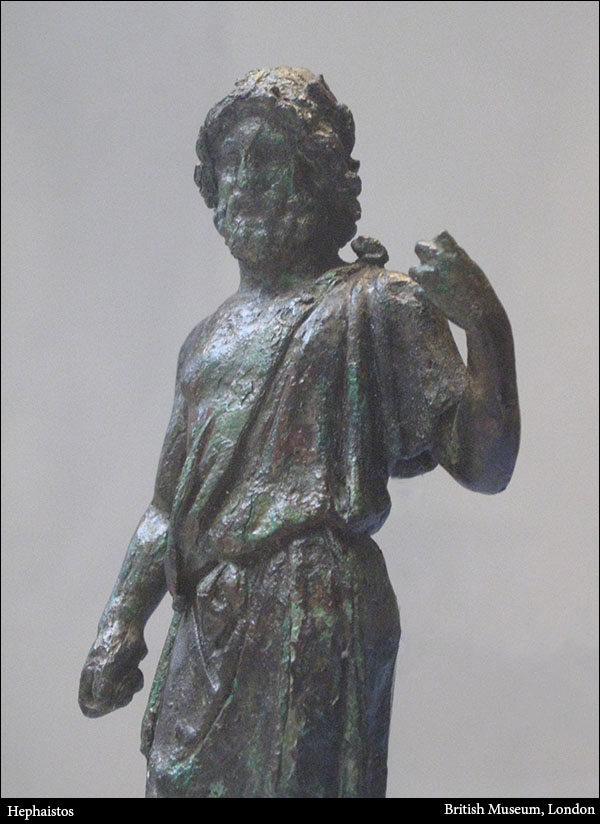
The Iliad
The Odyssey
Theogony
Works and Days
Catalogue of Women
Astronomy
Shield of Herakles
Hymn to Apollon III
Hymn to Hermes IV
The Argonautika by Apollonius of Rhodes
The Histories by Herodotos
Description of Greece by Pausanias
Library of History by Diodorus of Sicily